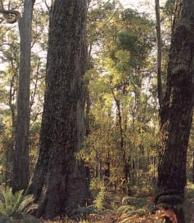

Common Name: jarrah,
swan river mahogany
Genus: Eucalyptus
Species: marginata

The jarrah is one of the many species of eucalyptus. The jarrah tree usually grows to about 40-50 meters high, with a trunk diameter of three meters. The trunk of the jarrah is long, straight, and has no branches on it. The jarrah tree has rough grayish brown bark with vertical grooves, which sheds in long strips.
The leaves of the jarrah tree are about 8 to 13 centimeters long. The top of the leaves are dark green and the bottom side is lighter. The species name of the plant "marginata" relates to the light colored vein around the edge of the leaf. The curved leaves are found at the top of the tree amongst the flowers.
The flowers of a jarrah tree are white with a cone shaped bud cap, 5-9 millimeters long. The flowers are found in groups of 7-11.
The flowers have a magnificent scent, while the ball shaped fruits grow to about 9-16 millimeters long. It flowers every other year making it a special event for bees to pollinate it and make honey. The jarrah tree can live as long as 500 years.
The jarrah tree usually grows in gravely soil, but occasionally it is found in sand or loam. The jarrah tree has widespread distribution in the dry Australian Savannah. It forms its forests or woodlands ranging from Albany to Gingin, and there is one very old tree in Manjimup that is dated 500 years old.
One of the adaptations the jarrah tree has made is called a lignotuber. The lignotuber is a large swelling underground. This swelling can store carbohydrates, and can make it possible for a young jarrah to grow back after a fire. Another adaptation the jarrah tree has made is its long roots. This makes it possible to pull up underground water during a drought. This drought resistance is helpful in its natural dry habitat.
The jarrah tree is mostly used for timber. Jarrah wood makes very durable, strong furniture and building materials, such as wharves, bridges and railroad ties. Before modern asphalt the streets of Berlin and London were paved with blocks of jarrah.
Another use of the jarrah tree is honey. Every other year when the jarrah flowers bloom, beekeepers have their bees pollinate the tree and make wonderful honey.
To some animals the jarrah tree is very useful. Birds and other animals use big holes in the jarrah tree to nest. Feral bees make their hives in holes in the tree. Nectar from the jarrah tree is also a main food source to many insects, marsupials, and birds
The jarrah trees population is decreasing because of heavy timbering. It is also very defenseless against dieback. Die back is a sort of algae that causes root-rot. This organism is related to the one that killed the potato crops of the Irish famine. Researchers are trying to make genetic transfers into the jarrah trees from the dieback resistant Marri gum, but it will take a long time.
by Celeste B. 2001
Bibliography:
Gentry, Alwin H. "Eucalyptus" World Book, 1997
Heinrichs, Ann "Australia, Enchantment of the World", Children's press, 1998
Lepthien, Emilie U. "Australia, Enchantment of the World" Regensteiner, 1982
"Plants and Animals; Jarrah", http://www.calm.wa.gov.au/plants_animals/treejarrah.html, (11/2/00)